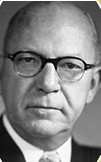-
(b.) -1898 May 31(d.)1972 March 27
Bio/Description
An IBM Fellow, he, along with Benjamin Durfee, assisted IBM?s Clair Lake in developing the large-scale calculator conceived by Harvard?s Howard Aiken. The Mark I calculator quickly solved problems for which the manual labor had previously been enormous. Statisticians were able to work with many more variables than had previously been possible, and differential equations, integral evaluations, and problems from all areas of applied mathematics were solved with a speed and accuracy that was previously unattainable. The Mark I consisted of 78 adding machines and calculators linked together. He was responsible for the primary organization, design, and construction of the Mark I; and he and Durfee designed the circuits that correlated the operations of the device?s components into a single working unit. In collaboration with Aiken, he also designed the circuits used to compute functions including logarithms, sines, and cosines. He was also responsible for the design of the IBM Selective Sequence Electronic Calculator (SSEC), an electromechanical computer completed in 1948, which was 250 times faster than the Mark I. In 1953, he developed the IBM 650 Magnetic Drum Calculator, of which nearly 2,000 were sold ? more than any electronic computer of its time. It was the first IBM computer to make a meaningful profit. In ?Building IBM: shaping an industry and its technology?, Emerson W. Pugh notes: "Frank Hamilton - who had learned to build computers by working on the one-of-a-kind Mark 1(sic) and SSEC supercomputers - had met the senior Watson's challenge. He had developed a machine for 'ordinary businesses' that became the most popular computer of the 1950s." He was named an IBM Fellow in 1963 and is believed to be the first IBM Fellow, appointed that year for, amongst other things, his work on the development of the IBM 650.
-
Date of Birth:
1898 May 31 -
Date of Death:
1972 March 27 -
Noted For:
Responsible for the primary organization, design and construction of the Automatic Sequence Controlled Calculator (ASCC) and for the IBM Selective Sequence Electronic Calculator (SSEC) -
Category of Achievement:
-
More Info:


